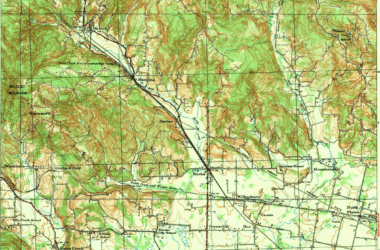An occasional column from the Tualatin Soil and Water Conservation District.
Guest Author: A. Taylor Johnson, ODF Small Forestland Owner Forester
My phone rings on a late summer’s day in 2019 during peak wildfire season. On the other end of the phone is my dad calling from Reno, Nevada.
“Taylor. I’m about to lose my house.”
I anxiously listened as he described the approaching blaze. With a shaken voice and incomplete sentences, it appeared his worry was growing as quickly as the wind-driven wildfire. Bear in mind, this is a man I have known all my life as calm, cool, and collected. However, as the wildfire approached, his calculated thinking was reduced to a panicked state of mind.
When he stopped to take a breath, I asked my dad if he had maintained the defensible space around his property. He said that he had, and that he also spent the previous spring expanding his defensible space.

What is defensible space?
Defensible space is the area around your house, and other structures, that is designed to reduce fire danger. Well maintained defensible space makes a huge difference in protecting your home or business during a wildfire.
According to the National Fire Protection Association (NFPA), defensible space is broken into three zones: Immediate, Intermediate, and Extended.

The Immediate Zone includes your house and the first five feet surrounding it. It is crucial to start wildfire preparedness work in the Immediate Zone first, as it is the most vulnerable to embers. This zone should be clear of all combustible fuel sources such as propane tanks, wooden fences, wood chips, stacked firewood, and dead leaves or pine needles. Embers from a nearby fire can land on these fuels, ignite, and carry a fire directly to your home.
The Intermediate Zone is 5-30 feet from your house. Preparing for wildfire in this zone focuses on creating gaps between fuels to decrease fire movement. For example, mow lawns and fields regularly, maintain at least 18 feet between tree crowns, limit shrubs to small clusters, and strategically place hard surfaces like driveways, walkways, and patios.
The Extended Zone is 30-100 feet from your home. The goal in this zone is to slow the fire down and keep it on the ground. This is done through activities like thinning trees to create more space, managing invasive weeds, and scattering large piles of woody debris.
Maintaining defensible space can be done while still providing habitat for wildlife.
It’s possible to have denser stands of trees for deer, small woody piles for insects and amphibians, and native shrubs and wildflowers for pollinators and birds while still protecting your home. The key is to be thoughtful in the placement of these habitat features.

Meanwhile in Reno – a rolling black column of smoke was bearing down on my dad and his home.
I was able to explain to him with high enough confidence that his home could survive this wildfire. Right now, he needed to shift his focus to evacuating his animals and grabbing his Go Bag. Because he spent the spring creating defensible space around his home, he could put aside worrying about the house and pay attention to safely evacuating.
“Okay, I’m packed and loaded. I just need to take one last look at the house.”
My dad managed to evacuate himself and his livestock in the nick of time. He followed the evacuation route and waited at the local fairgrounds where necessities were provided. His patience ran thin and ten hours later, around midnight, he drove back to his home, bracing for devastation. As he drove through the scorched area, he feared the worst.
But to his surprise, his house came into view untouched by the fire and surrounded by a clearly visible, unburned area. The defensible space he created saved his home.
In fact, his defensible space was so effective that local firefighters used his driveaway as a temporary refuge to let the flaming front pass. It was as unexpected, yet crucial, benefit to well maintained defensible space.

Local organizations are coming together to assist communities prepare for wildfire.
Local wildfire risk is increasing, and the impacts of a wildfire could be severe. Residents need to begin preparing for wildfire now.
Join us at Hagg Lake on Saturday, June 22nd for Wildfire Ready!
The day will bring together wildfire experts and natural resource specialists for presentations and hands-on demonstrations about wildfire risk, fire prevention, defensible space, and managing fuels in natural areas.
There will also be opportunities to speak with fire preparedness specialists about your unique property, emergency response planning, financial assistance opportunities, and more.
Registration is required. For complete details and registration, visit www.tualatinswcd.org/event/wildfire-ready
Other Resources:
Oregon Department of Forestry supports woodland owners with fire preparedness. Contact ODF Community Wildfire Forester, Rachel Mauch at 971-464-0520 or [email protected]
Non-woodland owning residents can also find support with defensible space through the Oregon State Fire Marshal and your local fire agency. Visit https://oregondefensiblespace.org to learn more.

Chas Hundley is the editor of the Banks Post and sister news publications the Gales Creek Journal and the Salmonberry Magazine. He grew up in Gales Creek and has a cat.





